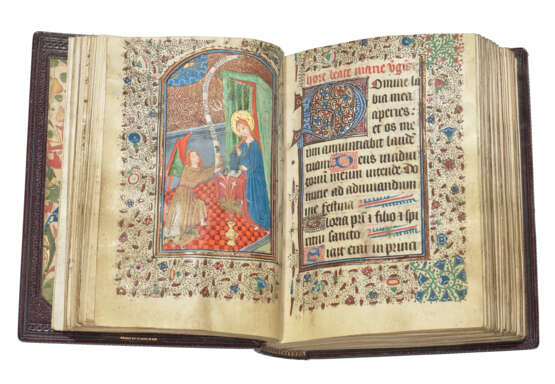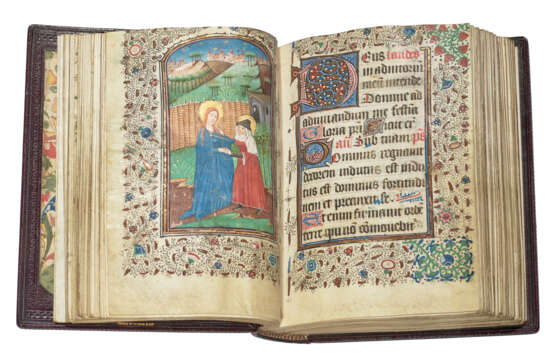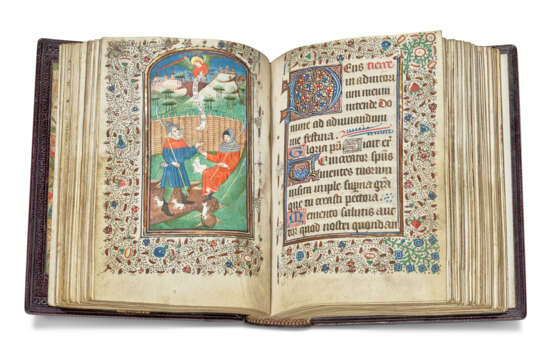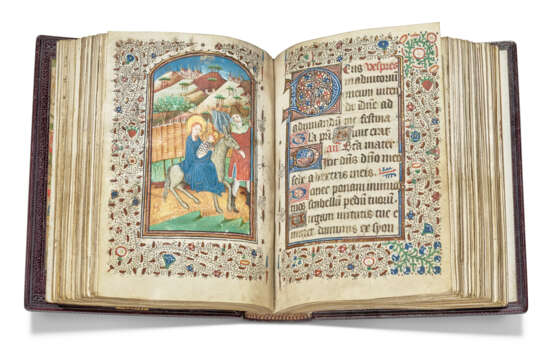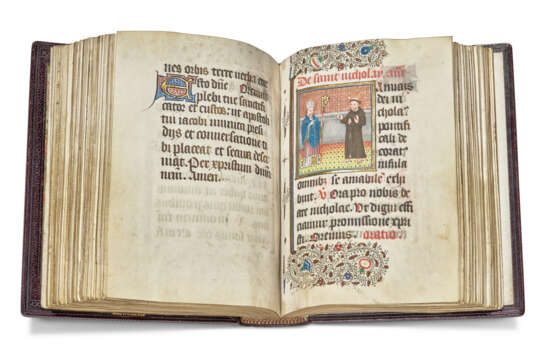ID 1249721
Lot 26 | Masters of the Gold Scrolls (active 1420-1450s)
Valeur estimée
£ 40 000 – 60 000
Book of Hours, in Latin and French, illuminated manuscript on vellum, [Bruges], 1445
A delightful example of southern Netherlandish illumination in the style of the Masters of the Gold Scrolls.
154 x 115mm. ii (vellum) + 177 leaves + ii (vellum), modern pencil foliation, collation following binder’s signature marks on first rectos: 112, 25 (of 4, iii inserted singleton with miniature), 3-48, 510, 612, 711, 813, 910, 10-118, 129, 1310, 148, 1510, 16-188, 195, 206, complete, 13 lines, ruled space: 100 x 67mm, rubrics in red, line-endings in red and blue, one-line initials alternately of burnished gold and blue with flourishing in black or red, two-line initials of burnished gold with blue and dark pink grounds with white penwork decoration, eleven large opening initials with patterned foliate or floral infills with full-page borders, fourteen large arch-topped miniatures with full-page borders and six small miniatures with pairs of standing Saints with three-quarter borders, a 15th-century Italian miniature pasted onto f.171v (small marginal repairs on ff.16 and 116v, some rubbing or smudging with occasional paint loss, noticeably to miniatures on ff.16v & 76v, a few borders closely cropped at upper edges, f.1 lightly browned). 20th-century binding in panelled, blind-stamped brown morocco by Rivière & Son, gilt edges; two borders from a late 15th-century French illuminated manuscript mounted inside upper cover, one showing Samson carrying away the gates of Gaza, the other Reuben emerging from the well.
Provenance:
(1) The calendar, in French, is appropriate for Flanders and includes saints venerated in Tournai and those important to nearby Lille. Amongst saints highlighted in red are Peter, Stephen, Bartholomew, Tournai’s patron, St Piat (1 October), Dionysus and Ghislain and, Eligius. Lucy, Prudentiana, Valeric and Petronilla are also included and Donatian appears on 14 October, a variant date for Tournai. The liturgical use, although unrecorded, appears to be a variation appropriate for Lille.
Easter dates in French have been supplied for the original owner on f.14r&v for the years 1445-49, the scribe providing space for dates to be filled in until 1461. Specific to the owner’s area are calculations for the dates of local annual festivities, for three days of fasting for each of the four seasons of the year: the first is for certain days after the ‘behourt’, referring to an annual tournament in Lille of jousting and combat, in which ‘les rois d’Epinette’ elected from the town’s patriciate chose other members of the bourgeois class to joust and celebrate ‘la feste qui est appelée de l’Espinette ou du Behourt’ (see Claude Fouret, ‘La violence en fête: la course de l'Epinette à Lille à la fin du Moyen Age’, Revue du Nord 249 (1981), pp. 377-390). The days in the final season are worked out in relation to the feast of St Lucy.
(2) An annotation in the month of July in the calendar and sewing holes and an imprint from pilgrims’ badges on ff.15 and 16 show use by an early owner.
(3) Sold at Christie's, 2 June 1999, lot 36.
Content:
Calendar ff.1-12; Easter dates for 1445-49 ff.14-14v; Hours of the Cross ff.17-25v; Office of the Virgin ff.27-96v: matins f.27, lauds f.41, prime f.55, terce f.62, sext f.67, none f.72, vespers f.77, compline f.86; Prayers to the Virgin and Christ opening Gaude flore virginali , Stabat mater and other prayers ff.98-105v; Suffrages ff.106-114v to Sts Michael f.106, John the Baptist f.106v; Peter f.107v, James f.108, Nicholas f.109, Francis f.109v, Adrian f.110v, Anthony f.111v, Maur f.112, Mary Magdalene f.112v, Apollonia f.113v, Anne f.114; Seven Penitential Psalms, Litany and sequence of innvocations ff.116-136; Office of the Dead ff.137-169v; added prayer to St Christopher f.170-170v; additional prayers opening Pater noster excellus in creatione ff.171-177.
Illumination:
The lively anecdotal scenes, rich patterning, sweet-faced figures and the bright palette uniting miniatures with surrounding borders are characteristic of the work of this prolific group of artists responsible for the most popular style of illumination in Bruges from around 1420 to 1450. The decorative gold filigree backgrounds that gave the Masters their name feature here in some of the large miniatures and in the suffrage miniatures which are particularly finely painted. They are combined with further gold patterning, in diapered backgrounds and halos, and with chequered floors, to great overall decorative effect. These features which are characteristic of the early style associated with the Gold Scrolls group, are similar to those in a Book of Hours for Sarum use now in The Hague, Museum Meermanno, Ms. MMW 10 F 11, dated c.1420-30, as are the borders, where gold and painted flowers and leaves on scrolling tendrils are combined with characteristic corner floral sprays. The same artisans were likely to have produced the borders in an Hours in Philadelphia, University of Pennsylvania Libraries, Ms. ljs004 and Norfolk, Swaffham Parish Church, Ms.1 (see Anne Margreet W. As-Vijvers & Dr Anne S. Korteweg, Splendours of the Burgundian Netherlands, 2018, pp.100-101). The Annunciation miniatures in both manuscripts share a compositional pattern familiar from the Masters’ oeuvre, with its distinctive green, curtained oratory of the Virgin. The inventive iconography and composition of the Last Judgement miniature is close to that in an Hours in the Walters Art Museum, Baltimore, Ms W. 263, f.94, likely destined for Tournai, c.1440-50. The retrospective, appealing features of the early style are seen too in the miniatures with landscape backgrounds, in which stylized hills, distant buildings and groups of trees are set improbably on a flat plane rather than receding into the distance, similar, for example, to compositions in an Hours c.1440 now in Cambridge, Fitzwilliam Museum, Ms 80.
This Hours is of particular interest because it is not a typical example of the prolific manuscript production in Bruges, where a large number of prayerbooks were made for the home market or for export to England; it is likely to have been compiled for a wealthy patron connected to Lille, whose devotional concerns were met by the inclusion of three miniatures from different workshops: St Quentin on f.13v and St Peter f.15, both relevant saints for the area, the latter sharing the same border style as the Weighing of Souls miniature on f.97v.
The subjects of the miniatures are as follows: Martyrdom of St Quentin f.13v; St Peter f.15; Crucifixion with the Virgin and John the Evangelist f.16v; Annunciation f.26v; Visitation f.40v; Nativity with the Adoration of the Christ Child f.54v, Annunciation to the Shepherds f.61v; Adoration of the Magi f.66v; Presentation in the Temple f.71v; Flight into Egypt f.76v; Coronation of the Virgin f.85v; St Michael holding the scales of judgement and defeating the devil, with the Virgin and Child f.97v; Last Judgement with Christ displaying his wounds seated on a rainbow, a Hellmouth in the foreground f.115v; Funeral Service f.136v; added miniature Pentecost f.171v.
The subjects of the small miniatures are: Sts Michael and John the Baptist f.106, Peter and James f.107v, Nicholas and Francis f.109, Adrian and Anthony f.110v, Maur and Mary Magdalene f.112, Apollonia and Anne f.113v.
| Lieu d'origine: | Belgique, Europe de l'Ouest, Europe |
|---|---|
| Catégorie maison de vente aux enchères: | Manuscrits médiévaux et de la Renaissance, Livres et manuscrits |
| Lieu d'origine: | Belgique, Europe de l'Ouest, Europe |
|---|---|
| Catégorie maison de vente aux enchères: | Manuscrits médiévaux et de la Renaissance, Livres et manuscrits |
| Adresse de l'enchère |
CHRISTIE'S 8 King Street, St. James's SW1Y 6QT London Royaume-Uni | |
|---|---|---|
| Aperçu |
| |
| Téléphone | +44 (0)20 7839 9060 | |
| Commission | see on Website | |
| Conditions d'utilisation | Conditions d'utilisation |
